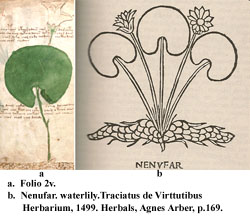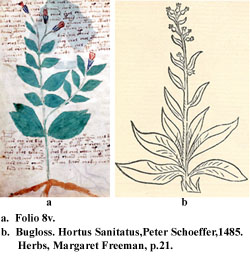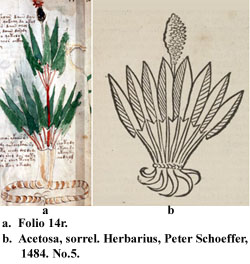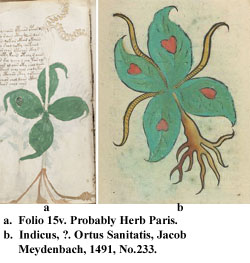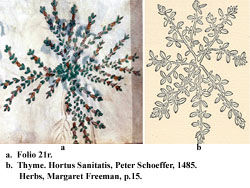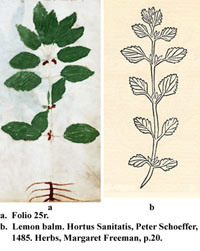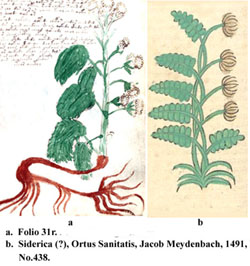The Voynich Botanical Plants
Folio 2r. Devil’s dung or giant fennel (Ferula foetida), is a large herbaceous plant with an unpleasant pungent smell. The gum or resin exuded by the roots of several species has antiviral properties and was used in 1918 to combat the Spanish influenza pandemic and more recently Taiwan researchers reported that it is able to kill the swine flue virus. (1) (A)
Folio 2v. Water lily (Nymphaea odorata) The Greeks named this plant after water nymphs or virgins because it was considered to have anti-aphrodisiac properties. Throughout the ages, the flower was the symbol of purity and chastity. The leaves and root were used to treat wounds, cuts and bruises. (1) (A)
Folio 3r. Salvia or garden sage (Salvia officinalis). The Romans called the plant salvia and used it as a diuretic and a local anesthetic for the skin. It was used during ancient times to treat snake bites. Its principal use today is culinary; sage and onion stuffing is popular at Thanksgiving. It may be effective in the management of mild to moderate Alzheimer’s disease. (2) (A)
Folio 8v. Bugloss (Anchusa officinalis). “According to Hortus Sanitatis this herb is good for him who has a wicked moisture of the lung and a bad cough. When drunk with water helps swollen feet, with wine develops good blood and when drunk with wine and honey makes a man merry and glad.” (2) (A)
Folio 14r. Sorrel (Rumex acetosa). This plant has been cultivated for centuries. Its sour tasting leaves are added to spice up salads, soups and stews. Oxalic acid, is responsible for sorrel’s sour taste . Sorrel is toxic when eaten in large quantities due to calcium oxalate stones that are deposited in the kidneys, causing kidney failure. Sorrel was used to treat sinusitis by reducing inflammation of the nasal mucous membranes and as a diuretic. (1) (A)
Folio 15v. Herb paris (Paris quadrifolia) Jacob Meydenbach labeled this plant Indicus, however it does not resemble the important Indian herb, Sphaeranthus indicus. The hearts on the leaves make it more likely to be Herb paris or true lover’s knot. Sprigs of Herb paris were worn in the spring to ensure true love and were believed to have aphrodisiac properties. Herb paris is described by Hortus Sanitatis “as being from Venus, useful in staunching the flow of blood and intestinal fluid.” (1) (A)
Folio 20r. Pennyroyal (Mentha pulegium). Pennyroyal was used as a cooking herb by the Greeks and Romans. Pseudo Apulenus recommended smearing a paste made from this herb and wormwood on the body to counteract seasickness. (1) (A)
Folio 21r. Thyme (Thymus vulgaris), “Thyme was grown in Medieval times to flavor soup and meat dishes. Dioscorides said that being eaten with meat it avails the dull sighted. He prescribed it mixed with honey for driving out “phlegmy from the thorax for asthema and for expelling worms. Oil of thyme, thymol, is an antiseptic that was once used on bandages and is a common ingredient of mouthwashes.” (2) (A)
Folio 25r. Lemon balm (Melissa officinalis) “Dioscorides says that the leaves of the balm being drunk with the wine and also applied are good for the scorpion-smitten and the dog-bitten. Being smeared on they will assuage the pains of the gout. The Grete Herball claims that meddled with grease, balm is good against all aches. Hortus Sanitatis claims “the leaves when eaten with salt will relieve the difficulty in breathing … and will clear the chest.” (2) (A)
Folio 31r. Siderica. The Latin name does not help in identifying this plant. The word siderica may refer to sidereal astrology. Medieval people believed in an association between certain plants and the stars, planets and moon. Herbals related to astrology are not currently available on the internet. (A)

